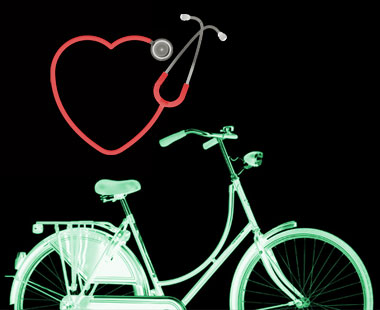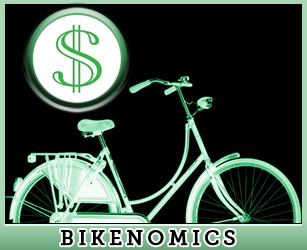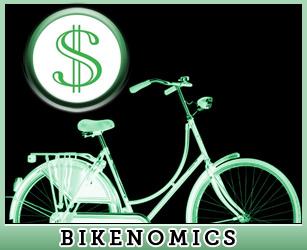This is the fourth column in a series focusing on the economics of bicycling.
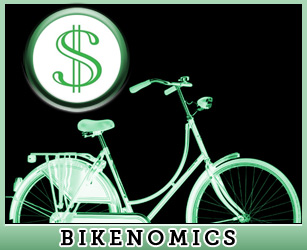 Bicycling and driving have one thing in common that is almost universally frustrating, time consuming, friction causing, and potentially expensive.
Bicycling and driving have one thing in common that is almost universally frustrating, time consuming, friction causing, and potentially expensive.
Parking.
No matter how seamless your ride across town, no matter how well-timed the traffic lights or low-conflict the bike lanes, it’s all pointless if when you arrive at work, or the store, or the music venue or party, and have nowhere to put your ride.
Worse is when you go back outside find your lock still securely attached and that sweet bike you invested in nowhere in sight.
Or when you buy the rustiest, most theft-proof bike you can find, and arrive at work sweaty because your gears don’t shift and covered in grease because your chain falls off every other block.
Or when you are running late for a meeting and hastily lock up to whatever is handy and then return to nothing — except, if you’re lucky, a note informing you it’s been impounded.
These are all real barriers to bicycling. And the solutions might seem difficult and costly … until you break them down and put them in perspective.
We bend over backwards to make car parking easy and cheap. The costs never seem to be too high, the urban real estate too valuable, or alternatives to driving worthy enough of actually incentivizing. Even though we can never build enough to keep up with demand, we keep demanding — and constructing — more. And to hell with the price.
Bike parking, on the other hand, is an afterthought in many municipalities, if it exists at all. Which is a real shame — because it can be a powerful economic development engine.
A recent study in Melbourne found that bike parking spaces are better at generating revenue than car parking spaces. In part, this is simply because bicycles take up so little space, and parking can provide more opportunities for paying customers to park right at a business’s front door.
And those customers may have more disposable income, not to mention more incentive and motivation to spend locally. Researchers have found that people who bike (and walk) to local retail businesses spend more money there [PDF].
Another finding in the latter study is that the business owners who benefited from this greater spending power were often unaware of it. Business owners are often the most powerful forces in maintaining unmetered street parking spaces for cars.
But in some of the emerging bike-friendly cities of the U.S. — take Santa Monica, Calif., as an example — business owners are among the first to catch on that well designed, visible bike parking, built in accordance with best practices, makes it easy and attractive for customers to ride to a business.
This doesn’t have to be expensive. Your basic on-sidewalk bike staple provides two parking spaces and costs between $100 and $300 to buy and install. In Seattle and Baltimore, they’re reusing old parking meter posts to curb the costs of transitioning to digital meters and create attractive bike parking all at once.
To compare: By one estimate, the average cost to build a single car parking space in the U.S. is $15,000.
Good bike racks also serve as a giant billboard trumpeting a business’s commitment to its bicycling customers and to sustainability and livability. On the other hand, when bike parking is poorly installed or hard to find, it says a lot about how little the business values those things.
Bike parking, along with bike lanes and reduced car traffic speeds, can be an important element in a multifaceted approach to making an area more bicycle friendly.
Take the example of Fort Worth, Texas, which recently paid just over $12,000 to purchase and install 80 new bike staples in its Near Southside shopping district, (thanks to Fort Worthology‘s Kevin Buchanan for the tip). Each staple holds two bicycles, so the total cost was $78 per space. An additional $160,000 is being spent to restripe the streets in the district, replacing two car traffic lanes with bike lanes. According to Buchanan the changes have resulted in a nearly 200 percent increase in business for restaurants on the district’s popular Magnolia Street.
Buchanan said that a car-parking garage in the district built in 2004 cost more than $5 million for 320 spaces — that’s more than $16,000 per space.
That’s right: It cost more to create a space to store a single car than it does to provide 160 bike parking spaces in the same area.
With those kinds of numbers, it’s no surprise that some cities and businesses are upping their bike parking budgets to get even more bang for their buck.
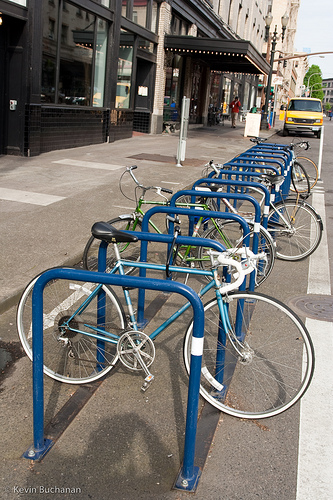 Portland businesses are lining up to have car parking replaced with bike parking corrals.Photo: Kevin BuchananEnter the bike corral, a bit of infrastructure that replaces one on-street car parking space with as many as 11 bicycle parking spaces at the cost of about $4,000.
Portland businesses are lining up to have car parking replaced with bike parking corrals.Photo: Kevin BuchananEnter the bike corral, a bit of infrastructure that replaces one on-street car parking space with as many as 11 bicycle parking spaces at the cost of about $4,000.
Portland, Ore., began to build these slowly, working out design kinks in partnership with business owners who desperately needed more bike parking. Despite initial grumbling about the removal of car parking, the corrals have taken off like wildfire. When business owners are lining up to complain that their car parking hasn’t been replaced with bike parking fast enough, and some of them start taking the project into their own hands, you know you’re onto something.
As of this writing, there are 59 well-used bike corrals replacing on-street car parking throughout the city, with a waiting list. More are being built all the time.
It’s not just Portland. Bike corrals are cropping up across the country, in places as far flung as Ashland, Ore., Los Angeles, Baltimore, and Cincinnati. The city of Eugene, Ore. has installed its first residential on-street bike corral.
Other more expensive — yet still appallingly affordable — parking solutions are starting to catch on in cities across the U.S. The dedicated bicycle parking lot is still a rare bird in this country, and the multi-level bicycle parking garage even more so, but they’re being built. The new BikeStation in Washington, D.C., provides train commuters and others with secure bike storage and gear lockers located seamlessly next to transit. Elsewhere, the concept of the “Bike & Ride” is starting to make the transition from good idea to funded reality.
Businesses don’t necessarily have to wait for the government to catch up to provide good bike parking options for customers and employees. While most office parking garages have a bike staple or two tucked away somewhere, others are taking bike parking seriously. And some establishments find it worthwhile to put their parking options front and center as a work of art…and a powerful marketing message.
Good bike parking is an essential feature of the bikeable urban landscape, and an important investment for cities. When people arriving at work or school or a store by bicycle are treated with the same priority and respect as people arriving by car, that will translate directly to the bottom line, for businesses and for city budgets.
